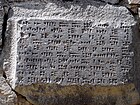History Museum of Armenia
This article needs additional citations for verification. (December 2014) |
Հայաստանի պատմության թանգարան | |
 The History Museum and the National Gallery share a building | |
 | |
| Established | 1920 |
|---|---|
| Location | Yerevan, Armenia |
| Type | national museum |
| Collection size | Archaeological, Numismatic, Ethnographic |
| Visitors | 106,900 (2019)[1] |
| Website | historymuseum.am |
The History Museum of Armenia (
History

On 9 September 1919, the
In 1935, the Central Committee of the Communist Party of Armenia, established separate museums. These museums received items that originally were part of the History Museum of Armenia:
- The Museum of Art of the Armenian SSR, was organized according to the History Museum's Department of Art (the current National Gallery of Armenia) and received 1,660 objects.
- The Museum of Literature, (the current Charents Museum of Literature and Arts) was formed from the History Museum's Department of Literature and received 301 objects and 1,298 manuscripts.
- The State Museum of Ethnography was founded in 1978 and received 1,428 objects and 584 photographs.
The museum continually replenishes its collections with finds from current excavations made at ancient Armenian sites by the Institute of Archaeology and Ethnography and the
Among its directors were Yervand Lalayan (1919-1927) and Karo Ghafadaryan (1940-1964).
Collections

- A large collection of 3rd to 2nd millennia BC bronze items.
- The historical-cultural heritage of Urartu, consisting of cuneiform inscriptions, bronze statuettes, wall-paintings, painted ceramics, arms, and weapons with sculptural ornamentation, excavated from Karmir Blur, Arin-Berd, and Argishtikhinili.
- The cuneiform inscription of 782 BC about the foundation of the city of Erebuni (Yerevan), by the Urartian king Argishti I.
- A collection of objects reflecting the history of transport. 15th-14th century BC wooden carts and chariots, excavated from Lchashen along with miniature models in bronze.
- A collection of Seljukgold, silver, and copper coins which have circulated in Armenia.
- A collection of Armenian coins, issued in Kiurike kingdom (11th century); and Armenian kingdom of Cilicia(1080-1375).
- Finds from the archaeological sites of Artashat, and Oshakan, specific to the transformation of Hellenistic culture in Armenia
- Finds excavated from the cities of Dvin, Ani, and the fortress of Amberd, reflecting 4th-5th-century Christian culture.

A replica of the Satala Aphrodite.
Objects with articles
- Statuette of a Bird (15th - 14th centuries BC, Lchashen)
- Pot With a Lid, Tricolor (16th-15th centuries BC, Karashamb)
- Statuette of a Wolf (6th - 5th centuries BC, Ayrum)
Exhibitions
The History Museum of Armenia has held exhibitions in Bochum in 1995, at the Bibliothèque nationale de France in Paris in 1996, in Musee Dobree Nantes in 1996, in Lyon in 1997, in Cairo in 1997, at the Zappeion Megaron of Athens in 1998, in Bonn, in Halle-Wittenberg in 1998, in Peking in 1998, at the Vatican Library in 1999, in Paris in 2000, at the British Library in London in 2001, in Rijksmuseum, in Leiden, in the Netherlands in 2001–2002, and in Budapest in 2002.
The museum has participated in various international exhibitions including ones in
For the first time, the History Museum of Armenia will exhibit the bronze head belonging to the statue of goddess Anahit from the British Museum collection. The exhibition will take place in September 2024.[4]
See also
- History of Armenia
- Yerevan History Museum
- National Gallery of Armenia
- List of Armenian genocide memorials
- Charents Museum of Literature and Arts
- Aram Khachaturian House-Museum
- Matenadaran
References
- ^ Nazaretyan, Hovhannes (10 February 2022). "Զբոսաշրջությունը հաղթահարում է կորոնավիրուսային շոկը [Tourism overcoming coronavirus shock]". civilnet.am. Archived from the original on 10 February 2022.
- ^ "History museum of armenia - History". Archived from the original on 2015-03-29. Retrieved 2015-05-11.
- ^ Tʻangaran, Petaken Patmakan; Amirian, S.; Hovhannisian, J. (1968). Guidebook to the State Historical Museum of Armenia. Ministry of Culture of the Armenian SSR.
- ^ "Впервые в Ереване будет экспонироваться бронзовая голова статуи богини Анаит из коллекции Британского музея" (in Russian). panorama. Retrieved 2024-02-04.


